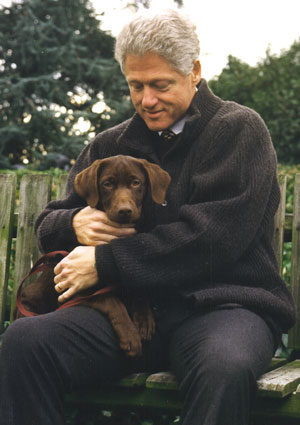I wonder if you have already heard about this new breed of Labradoodles? Sounds like a joke, I know, but it’s dead serious.
They look very woolly and sheep-like, compared to me, and appear to be bread for people who are allergic against our coat hair and “SMELL”!! (I wonder who dares calling my natural odeur like this!?).
Anyway – this is what I found on Wikipedia:
From Wikipedia, the free encyclopedia

A brown Labradoodle with a fleece type coat. The appearance of Labradoodles may vary. |
|
|
|
|
|
| Not recognized by any major kennel club |
|
A Labradoodle is a crossbred or hybrid dog created by crossing the Labrador Retriever and the Standard or Miniature Poodle.
History
The Labradoodle was first deliberately bred in 1989, when Australian breeder Wally Conron first crossed the Labrador Retriever and Standard Poodle for Guide Dogs Victoria. His aim was to combine the low-shedding coat of the Poodle with the gentleness and trainability of the Labrador, and to provide a Guide Dog suitable for people with allergies to fur and dander. Guide Dogs Victoria continue to breed Labradoodles today and Labradoodles are now often used around the world as Guide, Assistance, and Therapy Dogs as well as being popular family dogs.
Appearance and temperament
The Labradoodle as a dog breed is still developing, and does not yet “breed true,” i.e., puppies do not have consistently predictable characteristics. While many Labradoodles display desired traits, their appearance and behavioral characteristics remain, from an overall breed standpoint, unpredictable.
As such, Labradoodles’ hair can be anywhere from wiry to soft, and may be straight, wavy, or curly. Some Labradoodles do shed, although the coat usually sheds less and has less dog odor than that of a Labrador Retriever.
Like most Labrador Retrievers and Poodles, Labradoodles are generally friendly, energetic and good with families and children (although as with any dog the temperament may vary between individuals). Labradoodles also often display an affinity for water and the strong swimming ability present in both their parent breeds.
Like their parent breeds, both of which are amongst the world’s most intelligent dog breeds,Labradoodles are very intelligent and quite trainable. Labradoodles can be taught to obey verbal or sign language commands, or both, and remain commonly used as guide dogs for disabled or handicapped persons around the world.
Types of Labradoodle

A group of Labradoodle Assistance Dogs.

A three-month old Labradoodle
There is no universal consensus as to whether breeders should aim to have Labradoodles recognized as a breed . Some breeders prefer to restrict breeding to early generation dogs (i.e. bred from a Poodle and Labrador rather than from two Labradoodles) to maximise genetic diversity, in order to avoid the inherited health problems that have plagued some dog breeds.
Others are breeding Labradoodle to Labradoodle over successive generations, and trying to establish a new dog breed. These dogs are usually referred to as Multigenerational (abr. Multigen) or Australian Labradoodles. Australian Labradoodles also differ from early generation and Multigenerational Labradoodles in that they may also have other breeds in their ancestry. English and American Cocker Spaniel/Poodle crosses (ie Cockapoos), Two Irish Water Spaniels and Soft-Coated Wheaten Terriers have variously been used in some Australian Labradoodle lines. The Curly Coated Retriever were used too, but these lines did not work out and they were discontinued.
Labradoodle coats are generally divided into 3 categories: Wool (with tight curls, and similar in appearance to that of a Poodle, but with a softer texture); Fleece (soft and free-flowing, with a kinked or wavy appearance); or Hair (which can be curly, straight or wavy, but is more similar in texture to a Labrador’s coat) . Labradoodles come in a wide variety of colours, including chocolate, cafe, parchment, cream, gold, apricot, red, black, silver, chalk, parti colours, and generally all the colours that can be found in Poodles. They also can be different sizes, depending on the size of poodle (i.e. toy, miniature or standard) used.
Read Full Post »
































